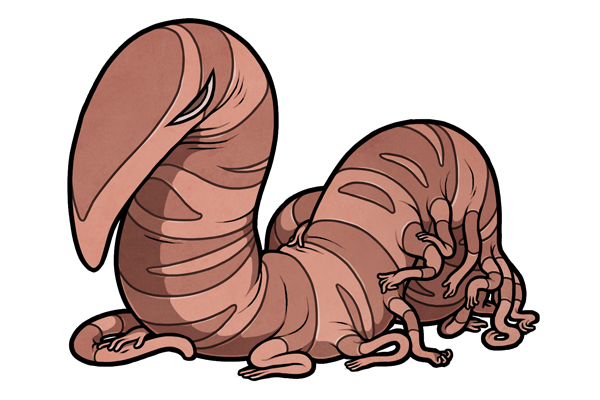

methusidrine
the intelligentsia
prefix methusi suffix drine
sophosii prudens
physical appearance
The methusidrine /məˈθuːzə.dɹiːn/ is a tall, large-headed and long-necked stranger with ruddy, peachy complexion and numerous thin, small-toed legs. Its skin is soft and warm to the touch, feeling organic in nature, but much more pliable than any human skin. This skin feels loose when touched, sliding easily over the methusidrine's inner flesh. The methusidrine's insides are meaty and firm, possessing an incredible density and strength.
Although muscular beneath, the methusidrine's soft and supple skin makes it vulnerable to injuries, and it tends to heal from wounds at a rate consistent with a human being. It can heal from small cuts with only minimal scarring, if any, significant injuries seems to trigger a rapid aging response as the methusidrine expends great amounts of energy healing itself.
It speaks only once every 1,650 days. The methusidrine's voice is varied but humanlike, and always mature in tone, and it speaks brief nonsense phrases in a language common to the city in which it dwells.
Death-defying but contemptuous, contemporary and wild.

environment and generation
The methusidrine appears in open spaces which have remained untouched by people for many years, with abandoned, open-sided buildings being its preferred point of generation. There, it grows from a fleshy base, which rises upward to form the methusidrine's protuberant head and neck in a series of swells. It does not ambulate during its initial stage of life, instead remaining still for several months, its effects diminished, before it engages in a brief but mesmeric circling dance which lasts for anywhere from five minutes to just under one week. Following this, it returns to a more stolid state and begins its inevitable roam.
behaviour and effects
The methusidrine possesses a patient and deific nature. Observant but unconcerned with its surroundings, it travels throughout its environment in unhurried, premeditated paths. It moves forward with much curling and uncurling of its limbs upon the ground, its motions smooth and its body level, and with little in the way of dragging or lifting. Its tail drags behind it as it moves, and it curls this appendage from side to side, using the tip to feel its surroundings.
Although it initially displays no clear environmental preferences, it does not enter tight spaces, and never lowers its head to clear doorways or other low openings. As such, it is often found in either exterior or open areas, such as warehouses or station lobbies. Despite the methusidrine's muscular body, it does not use its strength to open pathways or move objects around it, its every motion restrained.
Groups of methusidrine congregate infrequently, but with a monumental inevitability, converging in large, open rooms with domed ceilings, dusty air, and light that makes itself visible in the particles. There, they press their heads together and intertwine their arms, becoming still for months at a time before they disperse.
Aging strangers of all strains appear drawn to the methusidrine, making a final pilgrimage from their lairs to die at the methusidrine's feet, a gesture that the methusidrine itself remains ambivalent towards.
interactions with sensitives
The methusidrine inhibits short-term memory in sensitives; all thoughts which occur when in proximity of a methusidrine are forgotten within 33 seconds and 2 minutes, including the encounter itself. As such, contact with the methusidrine tend to be harmless, but disorienting.
In addition, 27% of encounters cause a prolonged sensation of unfamiliarity towards certain memories, particularly those occurring in adolescence. While the sensitive will continue to perceive those memories as their own, and will only view them as false or implanted in the case of existing delusional mental conditions and thought patterns, a sense of peculiarity will persist, with memories gradually growing less clear over time. This sense of unfamiliarity does not fade altogether, but becomes less pronounced within five to seven years following the inciting encounter.
In a further 9% of sensitives, appendages like hands or feet may seem unfamiliar for up to six hours and 50 seconds at a time.
The methusidrine appears to change its paths based on memories absorbed from the sensitives that it encounters. When able to, it travels to locations which bear some significance to the sensitives themselves, with childhood homes being of particular interest in the case of sensitives born or raised in the methusidrine-affected city.
The methusidrine itself displays only cursory interest in sensitives themselves, running a stray limb around a leg or brushing its tail across a sneaker-clad foot. When attacked, it shivers and shakes a bit, its skin vibrating particularly over the point of impact or around any cuts, but evasive or defensive behaviour remains unobserved.
aging and death
The methusidrine loses color throughout its life, its skin becoming pale and grey, and drooping from its form, which grows softer, its posture less erect. Its motions slow slightly, but grow no less coordinating, and the methusidrine retains a tranquil smoothness in its movements even as its head drags low and its skin sloughs off, revealing its age-darkened flesh beneath. It collapses silently, its great bulk disappearing upon impact, leaving behind only a faint cloud of dust which scatters in the air and settles upon its surroundings, a thin but persistent layer, pebbly and light.



